Information
Source: Wikipedia
Hanoiis the capital of Vietnam and the country's second largest city. Its population in 2009 was estimated at 2.6 million for urban districts, [1] 6.5 million for the metropolitan jurisdiction. The city is located on the right bank of the Red River. Hanoi is located at 1,760 km (1,090 mi) north of Ho Chi Minh City.October 2010 officially marked 1000 years since the establishment of the city. On this occasion, Hanoi was named by Frommer's travel guide as one of the world's "Top Destinations 2010".[3] LandmarksAs the capital of Vietnam for almost a thousand years, Hanoi is considered one of the main cultural centres of Vietnam, where most Vietnamese dynasties have left their imprint. Even though some relics have not survived through wars and time, the city still has many interesting cultural and historic monuments for visitors and residents alike. Even when the nation's capital moved to Huế under the Nguyễn Dynasty in 1802, the city of Hanoi continued to flourish, especially after the French took control in 1888 and modeled the city's architecture to their tastes, lending an important aesthetic to the city's rich stylistic heritage. The city hosts more cultural sites than any city in Vietnam and boasts more than 1,000 years of history, and that of the past few hundred years has been well preserved. |
 |
Old QuarterThe Old Quarter, near Hoan Kiem lake, has the original street layout and architecture of old Hanoi. At the beginning of the 20th century the city consisted of only about 36 streets, most of which are now part of the old quarter. Each street then had merchants and households specialized in a particular trade, such as silk traders, jewellery, etc. The street names nowadays still reflect these specializations, although few of them remain exclusively in their original commerce. The area is famous for its small artisans and merchants, including many silk shops. Local cuisine specialties as well as several clubs and bars can be found here also. A night market (near Đồng Xuân market) in the heart of the district opens for business every Friday, Saturday, and Sunday evening with a variety of clothing, souvenirs and food.Some others prominent places are: The Temple of Literature (Văn Miếu), site of the oldest university in Vietnam 1010; One Pillar Pagoda (Chùa Một Cột); Flag Tower of Hanoi (Cột cờ Hà Nội). In 2004, a massive part of the 900 year old Hanoi Citadel was discovered in central Hanoi, near the site of Ba Dinh Square. |
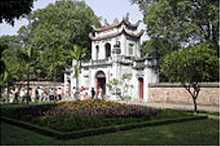 Main gate to the Temple of Literature |
LakesA city between the rivers, built from lowland, Hanoi has many scenic lakes and it is sometimes called "city of lakes". Among its lakes, the most famous are Hoan Kiem Lake, West Lake, Halais Lake (Hồ Thiền Quang in Vietnamese), and Bay Mau Lake. Hoan Kiem Lake, also known as Sword Lake, is the historical and cultural center of Hanoi, and is linked to the legend of the magic sword. West Lake (Hồ Tây) is a popular place for people to spend time. It is the largest lake in Hanoi and there are many temples in the area. There are small boats for hire and a floating restaurant. |
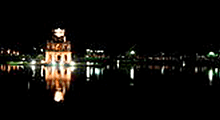 Hoan Kiem lake by night |
Colonial HanoiUnder French rule, as an administrative centre for the French colony of Indochina, the French colonial architecture style became dominant, many examples remain today: the tree-lined boulevards (e.g. Phan Dinh Phung street) and its many villas and mansions, Grand Opera House, State Bank of Vietnam (formerly The Bank of Indochina), Presidential Palace (formerly Palace of the Governor-General of French Indochina), Saint Joseph Cathedral, and the historic Hotel Metropole. Many of the colonial structures are an eclectic mixture of French and traditional Vietnamese architectural styles, such as the National Museum of Vietnamese History, the Vietnam National Museum of Fine Arts and the old Indochina Medical College. |
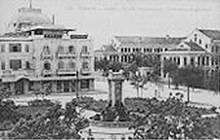 Hotel Metropole in colonial Hanoi |
MuseumsHanoi is also home to a number of museums:National Museum of Vietnamese History Vietnam National Museum of Fine Arts Vietnam Museum of Ethnology Vietnam Museum of Revolution Hanoi Hilton (Hoa Lo Prison) Ho Chi Minh Museum Contemporary Arts Centre Vietnam Military History Museum The Hanoi Museum (currently under construction until 2010) |
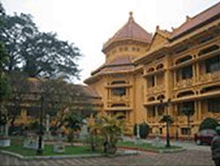 National Museum of Vietnamese History |
EntertainmentA variety of options for entertainment in Hanoi can be found throughout the city. Modern and traditional theaters, cinemas, karaoke bars, dance clubs, bowling alleys, and an abundance of opportunities for shopping provide leisure activity for both locals and tourists. Hanoi has been named as one of the top 10 cities for shopping in Asia by Smart Travel Asia.[14] The number of art galleries exhibiting Vietnamese art has dramatically increased in recent years, including galleries such as "Nhat Huy" of Huynh Thong Nhat.A popular traditional form of entertainment is water puppetry, which is shown for example at the Thăng Long Water Puppet Theatre. |
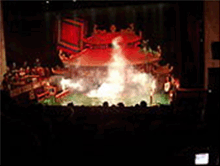 Performance of the water puppet theatre Thăng Long |
ShoppingWith its rapid growth and extremely high population density, several modern shopping centers have been built in Hanoi. Major centers include:Trang Tien Plaza, Hoan Kiem District Vincom City Towers, Ba Trieu Street, Hai Ba Trung District Ruby Plaza, 44 Le Ngoc Han Street, Hai Ba Trung District Parkson Department Store, Tây Sơn Street, Viet Tower, Dong Da District Big C Thăng Long Supercenter, Cau Giay District Metro AG, Tu Liem District The Garden Mall, Me Tri - My Dinh, Tu Liem District Vincom Shopping Galleries, Vincom Park Place, Hai Ba Trung District Ciputra Mall, Ciputra urban area, Tay Ho District (currently under construction) Yen So Shopping Mall, Hoang Mai District (currently under construction) |
|
CuisineHanoi has rich food traditions and many of Vietnam's most famous dishes, such as phở, chả cá, bánh cuốn and cốm are thought to come from Hanoi. Perhaps most widely known is Phở, a simple rice noodle soup often eaten as a breakfast dish in the home or at streetside cafes, but also served in restaurants as a meal. Two varieties dominate the Hanoi scene: Phở Bò, containing beef, and Phở Gà, containing chicken.Hanoi has been selected as one of the top 10 cities for food in the world by Shermans Travel.[15] Vietnam's national dish Phở has been also named as one of the Top5 streetfood in the world by globalpost.[16] Hanoi has a restaurant about the insect food, in Khuong Thuong village, Hanoi. The most special cuisines at his restaurant are those processed from ant-eggs, in the styles of Thai people or Muong and Tay ethnic people in Vietnam. |
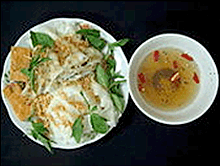 Bánh cuốn Thanh Tri dish |
Visa &Customs Detail
Individuals entitled to visa exemptions:
* Not more than 15 days: citizens of Japan, South Korea, Sweden, Norway, Denmark, Finland, Brunei Darussalam and Cambodia (14 days)
* Not more than 30 days: Bilateral visa exemption agreement
- Citizens of Thailand, Philippines (21 days), Malaysia, Indonesia, Singapore, and Laos (holding valid ordinary passports)
- Diplomatic and official passports holders from Myanmar; Iran (Diplomatic passport)
- Officials of the ASEAN secretariat holding different kinds of passports.
* Not more than 90 days:
- Vietnamese residing overseas and foreigners who are husbands, wives and children of Vietnamese citizens or Vietnamese residing overseas are entitled to visa exemption, so long as they meet the following requirements:
+ Foreign-issued permanent residence certificate (PRC) with the validity of at least six months since the date of entrance.
+ Visa exemption paper (VEP) is granted by Vietnamese appropriate authorities.
Those who expect to stay more than 90 days must apply for visa according to current stipulations before their entrance.
- Bilateral visa exemption agreement
Diplomatic and official passport holders from Argentine, Algeria, India, Bangladesh, Brazil, Chile, South Korean, Hungary, Iraq, Morocco, Mexico, Moldova, Mongolia, Montenegro, South Africa, Russia, Romania, Japan, Pakistan, Panama, Peru, France (diplomatic passport), Czech Republic (diplomatic passport), Serbia, Sri Lanka, Turkey, Ukraine, Venezuela, Singapore, Slovakia (diplomatic passport), Uruguay, Paraguay, Mozambique.
* No limit for temporarily residence:
+ Diplomatic and official passport holders from Albania, Afghanistan, Belarus, Bulgaria, Cuba, Cambodia, Kyrgyzstan, Laos, Japan (holding valid diplomatic or official passports for the purpose of diplomatic or consular missions or official Government tasks), Nicaragua, DPR of Korea, and China.
+ Valid ordinary passport hoders from China, Bulgaria, Kyrgyzstan, Cuba, DPR of Korea and Romania traveling on official missions.
Others who want to enter Vietnam must be provided with a visa
- Tourist visa is valid in 30 days.
- Visa is issued at the Vietnamese diplomatic offices or consulates in foreign countries. Visa is possibly issued at the border gates to those who have written invitations by a Vietnamese competent agencies or tourists in the tours organized by Vietnamese international travel companies.
- Application files for visa: the entrance application (printed form); two 4x6 cm photos; passport and fee for the visa issuance.
Visa extension: Served by all Tour Operators
* Not more than 30 days: Bilateral visa exemption agreement
- Citizens of Thailand, Philippines (21 days), Malaysia, Indonesia, Singapore, and Laos (holding valid ordinary passports)
- Diplomatic and official passports holders from Myanmar; Iran (Diplomatic passport)
- Officials of the ASEAN secretariat holding different kinds of passports.
* Not more than 90 days:
- Vietnamese residing overseas and foreigners who are husbands, wives and children of Vietnamese citizens or Vietnamese residing overseas are entitled to visa exemption, so long as they meet the following requirements:
+ Foreign-issued permanent residence certificate (PRC) with the validity of at least six months since the date of entrance.
+ Visa exemption paper (VEP) is granted by Vietnamese appropriate authorities.
Those who expect to stay more than 90 days must apply for visa according to current stipulations before their entrance.
- Bilateral visa exemption agreement
Diplomatic and official passport holders from Argentine, Algeria, India, Bangladesh, Brazil, Chile, South Korean, Hungary, Iraq, Morocco, Mexico, Moldova, Mongolia, Montenegro, South Africa, Russia, Romania, Japan, Pakistan, Panama, Peru, France (diplomatic passport), Czech Republic (diplomatic passport), Serbia, Sri Lanka, Turkey, Ukraine, Venezuela, Singapore, Slovakia (diplomatic passport), Uruguay, Paraguay, Mozambique.
* No limit for temporarily residence:
+ Diplomatic and official passport holders from Albania, Afghanistan, Belarus, Bulgaria, Cuba, Cambodia, Kyrgyzstan, Laos, Japan (holding valid diplomatic or official passports for the purpose of diplomatic or consular missions or official Government tasks), Nicaragua, DPR of Korea, and China.
+ Valid ordinary passport hoders from China, Bulgaria, Kyrgyzstan, Cuba, DPR of Korea and Romania traveling on official missions.
Others who want to enter Vietnam must be provided with a visa
- Tourist visa is valid in 30 days.
- Visa is issued at the Vietnamese diplomatic offices or consulates in foreign countries. Visa is possibly issued at the border gates to those who have written invitations by a Vietnamese competent agencies or tourists in the tours organized by Vietnamese international travel companies.
- Application files for visa: the entrance application (printed form); two 4x6 cm photos; passport and fee for the visa issuance.
Visa extension: Served by all Tour Operators
Customs
Customs procedures in Vietnam are quick and simple. To enter and exit Vietnam, visitors are required to fulfill the entrance and exit procedures in the form (in Vietnamese or in English languages). Luggage of people on entry (including clothes, personal belongings with reasonable quantity in service of the trip’s purpose) must be declared in case as follow:
• Luggage exceeds duty free concessions
• Luggage sent before or after trips
• Professional equipment temporarily imported and re – exported or vice versa;
• Addictive medicines
• Other medicines exceed 30 USD in value
• Foreign currency exceeds 7,000 USD (seven thousand US dollars) or its equivalence other foreign currency, or over 15,000,000 VND (fifteen million Viet Nam Dong) in cash.
* Goods prohibited to export: weapons, ammunition, explosives, military technical equipment, antiques, drugs, toxic chemicals, wild animals, rare and precious animals and plants, documents related to the national security, etc. A quantity over 300g of gold must be declared and be permitted by the State Bank.
* Duty free concessions for the baggage of arriving passengers:
- For liquor: Liquor at 22º and above: 1.5 litres; Liquor below 22º: 2.0 litres; Alcoholic beverage: 3.0 litres.
- For cigarettes and cigars: - Cigarettes: 400 pieces; - Cigar: 100 pieces; - Tobacco: 500g
- For tea, coffee: - Tea: 5kg; Coffee: 3kg
- For Clothes, personal belongings: With reasonable quantity in service of the trip’s purpose
- Articles other than those mentioned at items above (outside the list of goods banned from import or subject to conditional import): Total value not exceeds 5,000,000 VND.
* Note: Foreigners on entry carry luggage, which exceeds the duty-free quotas, presents and gifts with the total value not exceeding VND 1,000,000 (one million) shall be exempt from taxes.
Source: Vietnam National Administration of Tourism : http://www.vietnamtourism.gov.vn/
• Luggage exceeds duty free concessions
• Luggage sent before or after trips
• Professional equipment temporarily imported and re – exported or vice versa;
• Addictive medicines
• Other medicines exceed 30 USD in value
• Foreign currency exceeds 7,000 USD (seven thousand US dollars) or its equivalence other foreign currency, or over 15,000,000 VND (fifteen million Viet Nam Dong) in cash.
* Goods prohibited to export: weapons, ammunition, explosives, military technical equipment, antiques, drugs, toxic chemicals, wild animals, rare and precious animals and plants, documents related to the national security, etc. A quantity over 300g of gold must be declared and be permitted by the State Bank.
* Duty free concessions for the baggage of arriving passengers:
- For liquor: Liquor at 22º and above: 1.5 litres; Liquor below 22º: 2.0 litres; Alcoholic beverage: 3.0 litres.
- For cigarettes and cigars: - Cigarettes: 400 pieces; - Cigar: 100 pieces; - Tobacco: 500g
- For tea, coffee: - Tea: 5kg; Coffee: 3kg
- For Clothes, personal belongings: With reasonable quantity in service of the trip’s purpose
- Articles other than those mentioned at items above (outside the list of goods banned from import or subject to conditional import): Total value not exceeds 5,000,000 VND.
* Note: Foreigners on entry carry luggage, which exceeds the duty-free quotas, presents and gifts with the total value not exceeding VND 1,000,000 (one million) shall be exempt from taxes.
Source: Vietnam National Administration of Tourism : http://www.vietnamtourism.gov.vn/

Contacts (E-mail ):
Korea: Hyunsik Ahn (hsahn@tu.ac.kr) / Tel: +82-51-629-1563 / C.P.: +82-10-2518-4777
Vietnam: Vo Nguyen Quoc Bao(baovnq@ptithcm.edu.vn) / Tel: +84-83-9101-536 / C.P.: +84-91-3454-446
Korea: Hyunsik Ahn (hsahn@tu.ac.kr) / Tel: +82-51-629-1563 / C.P.: +82-10-2518-4777
Vietnam: Vo Nguyen Quoc Bao(baovnq@ptithcm.edu.vn) / Tel: +84-83-9101-536 / C.P.: +84-91-3454-446















